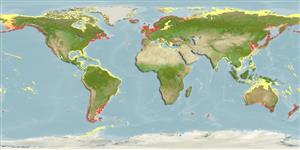Common names from other countries
Environment: milieu / climate zone / depth range / distribution range
Ecologia
; estuarina; intervalo de profundidade 0 - 60 m (Ref. 7726). Temperate, preferred 9°C (Ref. 107945); 89°N - 58°S, 112°E - 61°E
Circumpolar.
Length at first maturity / Tamanho / Peso / Idade
Maturity: Lm ? range ? - ? cm Max length : 11.0 cm SHL macho/indeterminado; (Ref. 95344); Idade máx. registada: 24 anos (Ref. 8702)
Minimum depth (intertidal zone) from Ref. 95344. Inhabits intertidal areas (Ref. 2789). Found in quiet, sheltered areas forming dense aggregates on hard surfaces; attached by strong byssal threads (Ref. 95344). In the Vainameri, north-eastern Baltic Sea, most abundant in silty substrate (Ref. 95753). It is infaunal on sand and eelgrass beds and epifaunal on eelgrass beds (Ref. 95819). Also found on mixed sediments with gravel (Ref. 118257). Semi-mobile suspension feeder (Refs. 95752, 96470). Feeds on phytoplankton such as green algae, dinoflagellates and diatoms (Ref. 95805).
Life cycle and mating behavior
Maturidade | Reprodução | Desova | Ovos | Fecundidade | Larvas
Members of the class Bivalvia are mostly gonochoric, some are protandric hermaphrodites. Life cycle: Embryos develop into free-swimming trocophore larvae, succeeded by the bivalve veliger, resembling a miniature clam.
Harvey-Clark, C. 1997. (Ref. 7726)
Categoria na Lista Vermelha da IUCN (Ref. 130435)
Categoria CITES (Ref. 108899)
Not Evaluated
Not Evaluated
Utilização humana
Pescarias: espécies comerciais
FAO - Aquacultura: produção, perfil da espécie; pescarias: landings, perfil da espécie | FishSource | Sea Around Us
Ferramentas
Fontes da internet
Estimates based on models
Preferred temperature
(Ref.
115969): 4.4 - 16.1, mean 10.2 (based on 1512 cells).
Resiliência
Elevada, tempo mínimo de duplicação da população menor que 15 meses (K=0.05-1.14; tmax=24).
Prior r = 0.54, 95% CL = 0.36 - 0.82, Based on 1 data-limited stock assessment.
Vulnerabilidade
Moderate vulnerability (36 of 100).
